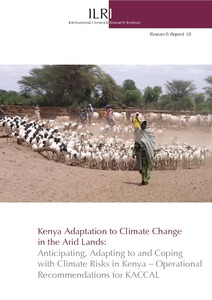Resource information
Years of concerted activism to bring awareness of climate change and its consequences to the fore of global concerns are finally yielding dividends. Until recently, most climate change activity focused on medium- to long-term projections regarding the nature and trajectory of change processes. With the uncertainties inherent in long-term climate projections and the difficulty of building political and economic momentum from hypothetical future scenarios, progress was slow. The recent past has, however, resulted in a drastic increase in extreme climate events across the globe that has wreaked untold humanitarian and economic havoc.
The costly present day manifestations of climate change have catapulted climate concerns to the forefront of the global arena. The recent high-level event convened by the Secretary General of the United Nations to address the leadership challenge of climate change and build momentum for climate change talks (Bali, Indonesia, December 2007) is a clear indication that the urgency of climate change has fostered the degree of serious commitment it requires from the global agenda.
Whatever its impacts, it is widely acknowledged that poor communities, already
vulnerable to a suite of existing risks and endowed with meagre resources, will be the most adversely affected as climate change is superimposed on their already tenuous situation. In recognition of the need to help vulnerable populations in developing
countries adapt to the adverse impacts of climate change, the Global Environment Facility (GEF), in conjunction with its partners, funds programmes aimed at reducing the vulnerability of countries to the impacts of climate change and helps them build adaptive capacity.
The Kenya Adaptation to Climate Change in the Arid Lands (KACCAL) project is one such initiative supported in conjunction with the World Bank and the United Nations Development Programme (UNDP). About 80% of Kenya is arid or semi-arid and the main livelihood activities in these areas are pastoral, agropastoral and subsistence agriculture. Currently, these populations are among the poorest in Kenya, suffer from a
weak natural resource base, are negatively affected by socio-economic and demographic trends that see a growing population depending on diminishing rangelands, and are
relatively marginalized from the growing economy. Add to this the impacts of climate
change, of which the recent severe and extended droughts of 2001, 2004–06 and the
widespread flooding in 2007 are an early signal, and the livelihood threats to the
communities of Kenya’s arid and semi-arid lands (ASAL) are clear and present.



